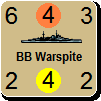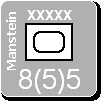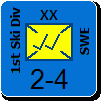warspite1
Posts: 41353
Joined: 2/2/2008
From: England
Status: offline

|
I am not sure if there are any Dutch on this Forum but if so then this is for you! The Dutch Navy write-ups are almost complete (one transport and a submarine to go). I am posting three write-ups for the usual feed-back, particularly important as Dutch info is more difficult to come by compared to the Royal Navy and research time is now limited. Before turning draft to final, I would like to know if there are any obvious errors. One question re the game - if a minor country is conquered, do I recall right that there is no ability for its future force pool additions to be built by the conquerer?
Many thanks
1/3
[4746 De Ruyter - by Robert Jenkins]
.B Engine(s) output: 66,000 hp
.B Top Speed: 32 knots
.B Main armament: 7 x 5.9-inch (150mm), 10 x 40mm guns
.B Displacement (Standard): 7,548 tons
.B Thickest armour: 2-inch (belt)
.P The Dutch Navy`s principal role was the protection of her main overseas
possession, the Dutch East Indies. The East Indies (modern day Indonesia)
provided the Netherlands with oil and other raw materials to meet her own
requirements and also provided her with vital export income.
.P To counter the growing threat to the colony posed by the Japanese, in 1930
the Dutch ordered the construction of a cruiser and five submarines. The
cruiser, named De Ruyter, was intended to join the two existing cruisers on
station.
.P Due to financial constraints she was limited to just 5,250 tons, although
during the construction phase there was some relaxation and she eventually came
in at 7,548 full load. The extra weight was caused by increasing her length and
in turn, this allowed the fitting of a single 5.9-inch "B" turret.
.P Her main armament was not impressive for a light cruiser and her anti-
aircraft (AA) armament was of limited use due to the concentration of the guns
aft. This provided only limited arcs of fire. These drawbacks were off-set
somewhat by her excellent fire control system.
.P Her top speed was 32 knots and she had an overload feature which increased
this to 33.5 knots for short periods.
.P De Ruyter was completed in October 1936 and sailed almost immediately for the
Far East where she arrived in March 1937.
.P When Holland was defeated by the Germans in May 1940, Dutch shipping in
European waters were placed under the control of the Admiralty, although this
did not apply to the forces guarding the Dutch East Indies and the naval forces
continued operating in the waters there under Dutch control.
.P In response to the Japanese attack on Pearl Harbor and Malaya in December
1941, the Dutch declared war on Japan the following day. De Ruyter and other
Dutch ships assisted the passage of Allied convoys as the British sought to hold
onto Malaya and Singapore; all to no avail. The calamitous start to the war with
Japan brought the assortment of American, British, Dutch and Australian naval
forces together under ABDA command on the 15th January 1942.
.P De Ruyter first saw action on the 4th February. She was the Flagship of Rear-
Admiral Doorman`s mixed US/Dutch force that also consisted of the cruisers
HNLMS Tromp, USS Houston and USS Marblehead and three Dutch and four US
destroyers. They were tasked with intercepting an enemy convoy heading for
Makassar but were spotted by an enemy aircraft and attacked in force. The two
US cruisers were badly damaged and, without air cover himself, Doorman withdrew.
This action is known as the Battle of Makassar Strait.
.P On the 13th February Doorman attempted to attack another Japanese invasion
convoy. This time his force consisted of the cruisers De Ruyter, Tromp, Java,
HMS Exeter and HMAS Hobart together with four Dutch and six US destroyers. Once
again however, the Allied ships failed to get anywhere near the convoy before
being attacked by aircraft on the 15th. This time there was no damage to the
Allied force but it was another demoralising episode.
.P Upon the sighting of another invasion fleet on the 18th; this time making for
Bali, Doorman set out with Java and three destroyers. They were later joined by
Tromp and four US destroyers. The piecemeal arrival of the Allied ships and the
lack of time to prepare all contributed to another defeat for ABDA command. The
operation started badly as the submarines USS Seawolf and HMS Truant were unable
to attack the convoy due to the heavy escort. In the ensuing engagement that
came to be known as the Battle of Badung Strait, the Tromp was badly damaged
and had to retire to Australia for repair, but for the destroyer Piet Hein, the
battle was to be her last. She was struck by a deadly Long Lance torpedo while
trying to make a torpedo attack herself. She sunk within a matter of minutes.
For no gain, the Allied force had to withdraw once more.
.P De Ruyter`s final battle came on the 27th February 1942; the Battle of the
Java Sea. With the seemingly unstoppable Japanese about to strike at Java, every
ship available to Doorman sailed to try and destroy the troop transports. For
this operation Doorman had the heavy cruisers HMS Exeter and the still damaged,
USS Houston; the light cruisers De Ruyter, Java and HMAS Perth and three
British, two Dutch and four US destroyers.
.P The Japanese convoy was escorted by two heavy cruisers, Nachi and Haguro, two
light cruisers, Naka and Jintsu and fourteen destroyers under the command of
Rear-Admiral Nishimura. The Japanese cruisers were more powerfully armed, a
disparity made worse by the damage to Houston`s B turret. They also had the Long
Lance torpedo that was to cause so much damage to the Allied ships.
.P The battle lasted over seven hours as the Allies continually tried to break
through to the troop convoy; each time without success. The battle began at
1616hrs but neither side was able to achieve any hits with one exception. Exeter
was struck by an unlucky shot that smashed into her boiler room. Doorman had
little choice but to order her withdrawal and she left the scene accompanied by
the Dutch destroyer Witte De With.
.P The next phase of the battle saw the Japanese launch a mass torpedo attack
and again the Japanese were in luck. The destroyer Kortenaer was hit by a single
torpedo and she broke in two before quickly disappearing beneath the waves. The
next victim was the British destroyer Electra, she inflicted damage on two enemy
ships but not without damage to herself and she soon had to be abandoned.
.P With things going from bad to worse Doorman broke off at 1800hrs. With night
falling the Allied ships then double backed and tried to take the convoy from
the rear. The four US destroyers however were not with them as they returned to
Java, out of ammunition. A second British destroyer, Jupiter hit a mine and sank
at 2125hrs.
.P The Allied ships had not got around the escorts however, and at 2300hrs, fire
was once more exchanged. The Long Lance torpedo then came into play with
devastating effect and both the De Ruyter and Java were hit about thirty minutes
later. For both, the damage caused was terminal and they both sank in the early
hours of the following morning. The two remaining cruisers and one destroyer
meanwhile had withdrawn.
.P 345 officers and men died aboard De Ruyter including Doorman.
< Message edited by warspite1 -- 6/27/2009 10:05:10 AM >
_____________________________
England expects that every man will do his duty. Horatio Nelson October 1805  |
 Printable Version
Printable Version






 - I did tell you I was rubbish with computers and files and stuff
- I did tell you I was rubbish with computers and files and stuff 



 The annoying this is that I have a book called Plan Z..and its rubbish!!
The annoying this is that I have a book called Plan Z..and its rubbish!!  At least you have confirmed the six names of the BB`s which is more than Plan Z was able to do.
At least you have confirmed the six names of the BB`s which is more than Plan Z was able to do.  .
.

 New Messages
New Messages No New Messages
No New Messages Hot Topic w/ New Messages
Hot Topic w/ New Messages Hot Topic w/o New Messages
Hot Topic w/o New Messages Locked w/ New Messages
Locked w/ New Messages Locked w/o New Messages
Locked w/o New Messages Post New Thread
Post New Thread